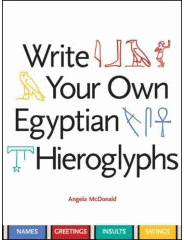Book Review: Write your own Egyptian Hieroglyphs

Write your own Egyptian Hieroglyphs, Angela McDonald,
When I first saw this for sale in the
The aim of the book, the author states clearly to “teach you how to write your own hieroglyphs”, which is certainly a new approach. The introduction describes how the aim is to teach the readers to create a persona for themselves by examining ancient Egyptian names, titles and labels. The idea is to involve readers in a one to one relationship with the hieroglyphs, encouraging them to think about names and comments to enable them to engage at least on superficial level, with the ancient Egyptian way of thinking. McDonald says that by learning to name people, pet is possible to see the Egyptian world through ancient Egyptian eyes.
After the introduction, which explains how the book is to be used and discusses the importance of naming in Ancient Egypt, McDonald discussed the hieroglyphic script, briefly explaining how it was deciphered before looking at how the script works in practise. She covers directions of writing, the order of hieroglyphs, the sound of ancient Egyptians, the different types of scripts which were used and then explains how the hieroglyphic script actually functions by combining sound and meaning signs. She wraps up the chapter with a small exercise which asks the reader to write their own name using symbols from the single consonant sign list and a selection of determinatives, both of which she provides.
The first full chapter is entitled “People and their Names”. In it, McDonald uses the whole topic of naming to bring Egyptian people and their beliefs to life: “As soon as a child was born, he or she was given a name that could serve as a protection. It could be done in different ways. The most common method was to link the child with a god”. A chart is included to show how names were often composed as part of a formulaic arrangement which would include the name of the deity – for example “beloved of Amun”. The goes on to handle the subjects of nicknames, family relationships, terms of endearment and occupations. Again, the chapter is wrapped up with a set of tools to enable the readers to create new names for themselves.
The People and their Names chapter forms the template for the next two – Gods and their Names and Animals and their Names. In Gods and their Names McDonald looks at how the name of a deity reflected that deity’s role in life, but she also mentions that some names, like that of Osiris, are difficult to interpret. The exercises at the end of the chapter encourage readers to 1) create their own demonic names and 2) to create a name for a sacred place. The Animals and their Names chapter is, as you might expect, rather endearing in places, and includes the terms for many animals that I have never seen mentioned in hieroglyphic form (e.g. spider, rhino, flea, lizard). McDonald looks at pets’ names, animal symbolism and the use of animal titles in human names.
Chapter 5 is slightly different. It looks at words and phrases in ancient Egyptian, digging into how worlds are put together and what the construction reveals. There are also greetings, insults and laments.
It is an enjoyable book and I will find the vocabulary useful. It offers a different way of understanding hieroglyphs and how they are assembled into words that capture wider concepts. It only offers a very basic insight into the grammar of the language, which you would expect in a book of this size, and it does this most effectively. It is the ultimate absolute beginner’s book.
If I had been given this when I was a hieroglyph-obsessed 12 year old I would have been very grateful, happy and hooked! Even as an intermediate Middle Egyptian reader in my mid 40s I learned some new facts and terms, and the book will certainly keep its home in my collection. At 5.99 with excellent diagrams, easy to read hieroglyph arrangements, pronunciation guidelines and photographs (many from the
If you are just starting out and don’t mind to start at a basic level, or if you have a bright and interested teenager on hand, this would be a good book to acquire.
- Book Review: Ancient Egypt: An Introduction
Bryn Mawr Classical Review (Reviewed by Peter C. Nadig) Salima Ikram, Ancient Egypt: An Introduction. Cambridge/New York: Cambridge University Press, 2010. It is not easy to write an introduction to ancient Egypt, since so many details, past and present,...
- Update - Glyphstudy Hieroglyph Courses 2009
A quick reminder that if you are intersted in learning hieroglyphs, free of charge, you can do so with the GlyphStudy group which is kicking off a new set of mutual-help courses this month. Here's the latest email from wonderful Karen at GlyphStudy:...
- The Egyptian Book Of Living And Dying
Joann Fletcher Duncan Baird Publishers London 2002 ISBN: 1-904292-05-4 This lovely and colourful paperback opens with an introduction on the ancient Egyptian religion and practices of their beliefs through complex and often conflicting systems of positive...
- Chronicle Of The Pharaohs
Peter A. Clayton Thames and Hudson New York 1994 ISBN-13: 978-0-500-28628-9 The book opens with the usual background information on Pharaonic Egypt including the authors intentions of tracing Egyptian history through kingship. The introduction deals...
- The World Of The Pharaoh's, A Complete Guide To Ancient Egypt
Christine Hobson Thames & Hudson New York ISBN: 0-500-27560-2 1987 The author starts out strong in its introduction with an interesting overview of Pharaonic history leading into the archaeologists who discovered the various epoch's of Egypt's...
